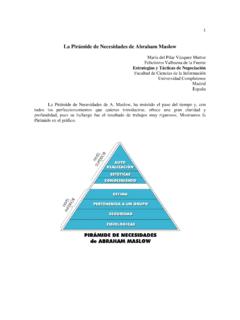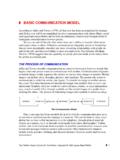Transcription of MOTIVATION - Stephen Walker
1 ABRAHAM MOTIVATION PERSONALITY PDF compression, OCR, web optimization using a watermarked evaluation copy of CVISION PDFC ompressorCopyright 1954 by Harper & Row,Publishers, Inc. Copyright 1970 by Abraham H. maslow Reprinted from the English Edition by Harper & Row, Publishers 1954 PDF compression, OCR, web optimization using a watermarked evaluation copy of CVISION PDFC ompressorThis book was made possible by the generosity of my brothers Harold, Paul, and Lew of the Universal Container Corporation PDF compression, OCR, web optimization using a watermarked evaluation copy of CVISION PDFC ompressorrREFACE X 1. A Psychological Approach to Science 2. Problem Centering vs.
2 Means Centering in Science Il 3. Preface to MOTIVATION Theory 19 4. A Theory of human MOTIVATION 35 5. The Role of Basic Need Gratification in Psychological Theory 59 6. The Instinctoid Nature of Basic Needs 77 7. Higher and Lower Needs 97 8. Psychopathogenesis and the Theory of Threat 05 9. Is Destructiveness Instinctoid? 117 10. The Expressive Component of Behavior 131 11. Self-Actualizing People: A Study of Psychological Health 49 12. Love in Self-Actualizing People 181 13. Cognition of the Individual and of the Generic 203 14. Unmotivated and Purposeless Reactions 229 15. Psychotherapy, Health, and MOTIVATION 241 16. Normality, Health, and Values 265 Appendix A: Problems Generated by a Positive Approach to Psychology 281 Appendix B: Holistic-Dynamics, Organismic Theory, Syndrome Dynamics 295 BIRL1 OCRAPHY 329 INDEX OF NAMES 355 INDEX OF SUBJECTS 360 ViL PDF compression, OCR, web optimization using a watermarked evaluation copy of CVISION PDFC ompressorP R E FACE I have tried in this revision to incorporate the main lessons of the last sixteen years.
3 These lessons have been considerable. I consider it a real and extensive revision-even though I had to do only a moderate amount of rewriting-because the main thrust of the book has been modified in important ways which I shall detail below. When this 1)00k appeared in 1954 it was essentially an effort to build upon the classical psychologies available rather than to repudiate them or to establish another rival psychology. It attempted to enlarge our con- ception of the human personality by reaching into the "higher" levels of human nature. (The title I had first planned to tise for the book was High r Ceilings for Human Nature.) If I had had to condense the thesis of this book into a single sentence, I would have said that, in addition to what the psychologies of the time had to say about human nature, man also had a higher nature and that this was instinctoid, , part of his essence.
4 And if I could have had a second sentence, I would have stressed the profoundly holistic nature of human nature in contradiction to the analyticdissectingatomisticNewtonian approach of the behaviorisms and of Freudian psychoanalysis. Or to say it another way, I certainly accepted and built upon the available data of experimental psychology and psychoanalysis. I accepted also the empirical and experimental spirit of the one, and the unmasking and depth-probing of the other, while yet rejecting the images of man ix PDF compression, OCR, web optimization using a watermarked evaluation copy of CVISION PDFC ompressorx Preface which they generated. That is, this book represented a different philoso- phy of human nature, a new image of man.
5 However, what I took then to be an argument within the family of psychologists has in my opinion turned out since then to be rather a local manifestation of a new Zeitgeist, a new general comprehensive philosophy of life. This new "humanistic" Weltanschauung seems to he a new and far more hopeful and encouraging way of conceiving any and every area of human knowledge: , economics, sociology, biology, and every pro- fession: , law, politics, medicine, and all of the social institutions: , the family, education, religion, etc. I have acted upon this personal conviction in revising this book, writing into the psychology presented herein, the belief that it is an aspect of a much broader world view afl(l of a comprehensive life-philosophy, which is already partly worked out.)
6 At least to the point of plausibility, and must, therefore, be taken seriously. I must say a word about the irritating fact that this veritable revolution (a new image of man, of society, of nature, of science, of ultimate values, of philosophy, etc., etc.) is still almost completely overlooked by much of the intellectual community, especially that portion of it that controls the channels of communication to the educated public and to youth. (For this reason I have taken to calling it the Unnoticed Revolution.) Many members of this community propound an outlook characterized by a profound despair and cynicism which sometimes degenerates into corrosive malice and cruelty. In effect they deny the possibility of im- proving human nature and society, or of discovering intrinsic human values, or of being life-loving in general.
7 Doubting the realness of honesty, of kindness, of generosity, of affection, they go beyond a reasonable skepticism or a withholding of judgment into an active hostility when confronted by people whom they sneer at as fools,"Boy Scouts," squares, innocents, do-gooders, or Polly- annas. This active debunking, hating and rending goes beyond contempt; it sometimes looks like an outraged counterattack against what they consider to be an insulting effort to fool them, to take them in, to pull their legs. The psychoanalyst would, I think, see in it a dynamics of rage and revenge for past disappointments and disillusionments. This subculture of despair, this "more corrosive than thou" attitude, this counter-morality in which predation and hopelessness are real and good will is not, is flatly contradicted by the humanistic psychologies, and by the kind of preliminary data presented in this book and in many of the writings listed in the Bibliography.
8 While it is still necessary to be very cautious about affirming the preconditions for "goodness" in human PDF compression, OCR, web optimization using a watermarked evaluation copy of CVISION PDFC ompressorPreface xi nature (see Chapters 7, 9, 11, 16), it is already possible to reject firmly the despairing belief that human nature is ultimately and basically depraved and evil. Such a belief is no longer a matter of taste merely. It can now be maintained only by a determined blindness and ignorance, by a re- fusaI to consider the facts. It must therefore be considered to be a per- sonal projection rather than a reasoned philosophical or scientific position. The humanistic and holistic conceptions of science presented in the first two chapters and in Appendix B have been powerfully corroborated by many developments of the past decade, l)ut especially by Michael Po- lanyi's great book Personal Knowledge (376).
9 My own book, The Psy- chology o! Science (292), carries forward very similar theses. These books are in blunt contradiction to the classical, conventional philosophy of science still too widely prevalent, and they offer a far better substitute for scientific work with persons. The book is holistic throughout, but a more intensive and perhaps more difficult treatment is contained in Appendix B. Holism is obviously true-after all, the cosmos is one and interrelated; any society is one and interrelated; any person is one and interrelated, yet the holistic ut1ook his a hard time being implemented and being used as it should be, as a way of looking at the world. Recently I have become more and more inclined to think that the atomistic way of thinking is a form of mild psychopathology, or is at least one aspect of the syndrome of cog- nitive immaturity.
10 The holistic way of thinking and seeing seems to come quite naturally and automatically to healthier, self-actualizing people, and seems to he extraordinarily difficult for less evolved, less mature, less healthy people. To date this is only an impression, of course, and I do not want to push it too hard. Yet I feel justified in presenting it here as a hypothesis to be checked, something which should be rela- tively easy to do. The MOTIVATION theory presented in Chapters 3 through 7, and to some extent throughout the book, has had an interesting history. First presented in 1912 to a psychoanalytic society, it was an effort to integrate into a single theoretical structure the partial truths I saw in Freud, Adler, J sing, D.









